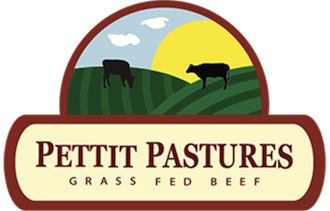Pettit Pastures February 2015
Today is Saturday, February 21st. Yesterday we began the process of weaning calves at Pettit Pastures. Most conventionally raised beef calves are weaned at 6-7 months of age. We wait until our calves are 10 months of age before weaning.
Waiting until the calves are 10 months old has several advantages. The first of which is that to become most efficient at digesting forage, a calf needs to stay on its mother so the rumen can develop to optimum potential. The butterfat in a cow’s milk enables the villi in the rumen to fully develop. If the calf doesn’t get the butterfat for 10 months, its digestive ability is inferior to what the genetics would dictate. This means that when weaned before 10 months, the calf will never be as efficient at converting forge to energy as it would have been if it was weaned at 10 months of age.
[/et_pb_text][/et_pb_column][/et_pb_row][et_pb_row _builder_version=”3.19.3″][et_pb_column type=”3_5″ _builder_version=”3.19.3″ parallax=”off” parallax_method=”on”][et_pb_text _builder_version=”3.19.3″]Another benefit of weaning at 10 months, is that the calf stays with its mother for an extra few months. This helps the calf learn more about how to forage, how to stay warm in the winter, and how to act within the herd. All of these factors help the calf become a low maintenance and very efficient cow.
The last benefit to weaning at 10 months instead of 6-7, is that it is less stressful for the calf. Weaning can be a hard. Many calves get sick and may even die because of the stress. The most common way to wean is to separate them from their mothers by placing them in different pastures or pens. The problem with this is that the calves stop getting the milk from their mothers, and at the same time, are separated from them. This introduces two major stressors simultaneously.
[/et_pb_text][/et_pb_column][et_pb_column type=”2_5″ _builder_version=”3.19.3″ parallax=”off” parallax_method=”on”][et_pb_image src=”https://www.pettitpastures.com/wp-content/uploads/2019/01/feb-2015.jpg” _builder_version=”3.19.3″][/et_pb_image][/et_pb_column][/et_pb_row][et_pb_row _builder_version=”3.19.3″][et_pb_column type=”4_4″ _builder_version=”3.19.3″ parallax=”off” parallax_method=”on”][et_pb_text _builder_version=”3.19.3″]At Pettit Pastures, we try to break up this process by using weaning rings. The ring fits into the nose of the calf and hangs down in front of its mouth. This makes it difficult for the calf to get its mothers teat into its mouth. The ring also has nobs on it so that when the calf tries to suckle, the nobs rub against the cows udder. The cow discourages the calf from trying to suckle, just like it would in a nature. We leave these rings in the calves for two to three weeks. By this time, the calves have gotten used not not having milk anymore. The next step then is to seperate the cows and the calves. We have found this process to be a very easy transition after the calves are used to not having milk anymore. When we move the calves, after having the rings in for a couple of weeks, we see little to no signs of stress and have not had any of our calves get sick during the process. If you have any questions or comments, please leave them below.[/et_pb_text][/et_pb_column][/et_pb_row][/et_pb_section]
